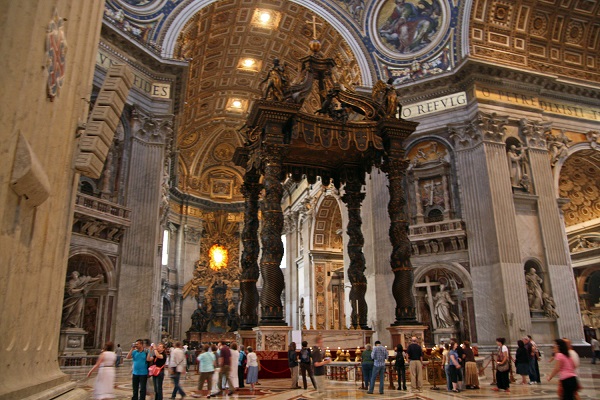“I looked up at the great basilica, and I had two reactions: First, I appreciated its beauty and reverence; but then I thought, ‘What corruption caused someone to spend so much on this building when people are hungry’?”
* * * * *
I made a new friend on the train this week. Mark described himself as a Christian but not a Catholic. As Amtrak #358 sped along the track from Chicago, where I’d been attending a conference, to Dearborn, Mark and I chatted about a lot of things: about our families, about our work, and about faith. When he heard that I was a Catholic writer, he embraced the opportunity to raise a few questions about Pope Francis and to express some concerns that he had with the Church, as he understood it.
I know that Mark’s questions are echoed by many others who see the Church from the outside, but who have never talked to a real Catholic to get an insider’s perspective. So here goes, in what will likely become a series of Quick Takes on the Catholic Faith.
Today: The Church’s wealth.
* * * * *
Mark had a good point: Certainly there are widows and orphans to feed, refugees to house, expectant mothers to assist and abandoned spouses to comfort. Mindful of all of these profound needs, shouldn’t the Church divest itself of its great wealth and give it all to the poor?
* * * * *
I’d like to suggest four key reasons why selling all is NOT the approach mandated by the Scriptures.
1. Gratitude Requires That We Preserve the Gifts of Those Who Have Gone Before Us. Wouldn’t you seem ungrateful if your parents had scrimped and saved to give you a pricey wedding gift, only to have you cast it aside? Likewise, past generations of the faithful–grateful for God’s beneficent care, and eager to share their appreciation by giving of their blessings–have donated the funds, or contributed the artwork, or supported the artist, with the expectation that their gift will be appreciated and will serve as an inspiration to prayer for future generations.
2. Jesus himself expected that we would honor him with our wealth. Remember the story in Luke 12, when the woman washes Jesus’ feet with her hair, and anoints them with expensive nard? It’s Judas who objects–insisting that the perfume could have been sold, and the money used to feed the poor. But rather than agreeing with Judas, Jesus scolds him–reminding him that the poor, we will always have with us. Here is the story (American Standard Version):
3 Mary therefore took a pound of ointment of pure nard, very precious, and anointed the feet of Jesus, and wiped his feet with her hair: and the house was filled with the odor of the ointment.
4 But Judas Iscariot, one of his disciples, that should betray him, saith,
5 Why was not this ointment sold for three hundred shillings, and given to the poor?
6 Now this he said, not because he cared for the poor; but because he was a thief, and having the bag took away what was put therein.
7 Jesus therefore said, Suffer her to keep it against the day of my burying.
8 For the poor ye have always with you; but me ye have not always.
Jesus was God, and was worthy of devotion. Even though there were poor people to be served, it was fitting that he should have been honored by her anointing with the precious oil. In the same way, it is right and good to build something (or paint something, or sculpt something) truly beautiful for God.
3. The Poor Deserve Beauty, Too.
If the great art of the Church were sold, it would most likely be preserved behind closed doors, in private collections of the very wealthy. Better, I think, to allow everyone–even persons of humble means–to enjoy the works of the Masters, to allow their hearts and minds to be drawn upward toward heaven by the rich imagery of the saints, by the glow of alabaster and the sheen of marble and the intricacy of fine metalwork. The Church has been a repository of great art, and has made its treasures available for all to enjoy.
4. Beauty Leads Us to Holiness.
Thomas Aquinas named three characteristics of beauty: integritas (integrity), consonantia (proportion), and claritas (clarity). Beauty is something which we recognize in creation, and it leads us to greater understanding of God, who in creating the Beautiful has shown us a little of His boundless Beauty. As we appreciate the beauty of a flower, we begin to understand a little more of the beauty of its Creator, and we are drawn to love Him more. Likewise, when a stained glass window enraptures us with its shimmering color and its profound imagery, we appreciate the creator (the artist), and the Creator of the creator (God).










